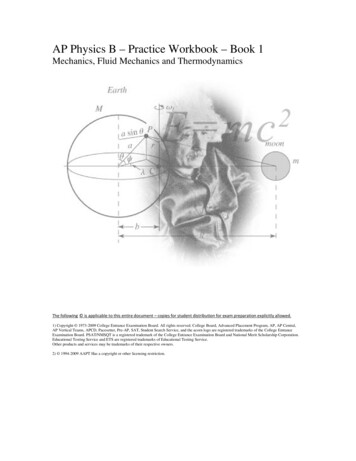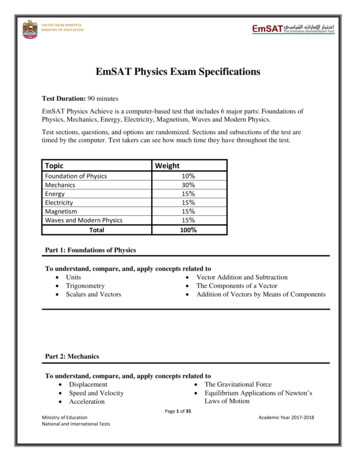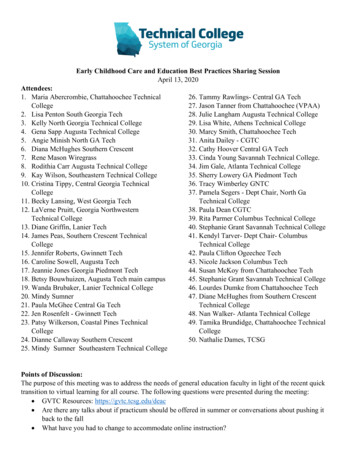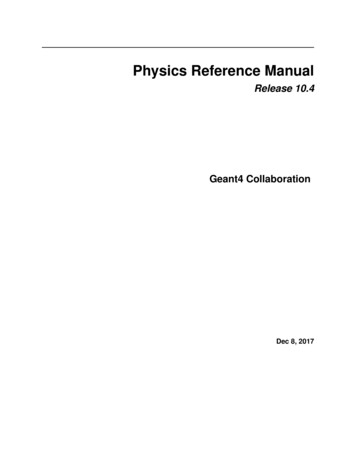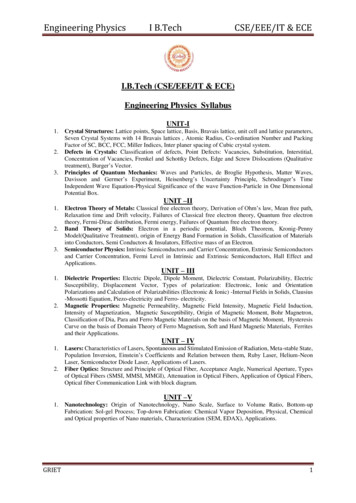
Transcription
Engineering PhysicsI B.TechCSE/EEE/IT & ECEI.B.Tech (CSE/EEE/IT & ECE)Engineering Physics SyllabusUNIT-I1.2.3.Crystal Structures: Lattice points, Space lattice, Basis, Bravais lattice, unit cell and lattice parameters,Seven Crystal Systems with 14 Bravais lattices , Atomic Radius, Co-ordination Number and PackingFactor of SC, BCC, FCC, Miller Indices, Inter planer spacing of Cubic crystal system.Defects in Crystals: Classification of defects, Point Defects: Vacancies, Substitution, Interstitial,Concentration of Vacancies, Frenkel and Schottky Defects, Edge and Screw Dislocations (Qualitativetreatment), Burger’s Vector.Principles of Quantum Mechanics: Waves and Particles, de Broglie Hypothesis, Matter Waves,Davisson and Germer’s Experiment, Heisenberg’s Uncertainty Principle, Schrodinger’s TimeIndependent Wave Equation-Physical Significance of the wave Function-Particle in One DimensionalPotential Box.UNIT –II1.2.3.Electron Theory of Metals: Classical free electron theory, Derivation of Ohm’s law, Mean free path,Relaxation time and Drift velocity, Failures of Classical free electron theory, Quantum free electrontheory, Fermi-Dirac distribution, Fermi energy, Failures of Quantum free electron theory.Band Theory of Solids: Electron in a periodic potential, Bloch Theorem, Kronig-PennyModel(Qualitative Treatment), origin of Energy Band Formation in Solids, Classification of Materialsinto Conductors, Semi Conductors & Insulators, Effective mass of an Electron.Semiconductor Physics: Intrinsic Semiconductors and Carrier Concentration, Extrinsic Semiconductorsand Carrier Concentration, Fermi Level in Intrinsic and Extrinsic Semiconductors, Hall Effect andApplications.UNIT – III1.2.Dielectric Properties: Electric Dipole, Dipole Moment, Dielectric Constant, Polarizability, ElectricSusceptibility, Displacement Vector, Types of polarization: Electronic, Ionic and OrientationPolarizations and Calculation of Polarizabilities (Electronic & Ionic) -Internal Fields in Solids, Clausius-Mossotti Equation, Piezo-electricity and Ferro- electricity.Magnetic Properties: Magnetic Permeability, Magnetic Field Intensity, Magnetic Field Induction,Intensity of Magnetization, Magnetic Susceptibility, Origin of Magnetic Moment, Bohr Magnetron,Classification of Dia, Para and Ferro Magnetic Materials on the basis of Magnetic Moment, HysteresisCurve on the basis of Domain Theory of Ferro Magnetism, Soft and Hard Magnetic Materials, Ferritesand their Applications.UNIT – IV1.2.Lasers: Characteristics of Lasers, Spontaneous and Stimulated Emission of Radiation, Meta-stable State,Population Inversion, Einstein’s Coefficients and Relation between them, Ruby Laser, Helium-NeonLaser, Semiconductor Diode Laser, Applications of Lasers.Fiber Optics: Structure and Principle of Optical Fiber, Acceptance Angle, Numerical Aperture, Typesof Optical Fibers (SMSI, MMSI, MMGI), Attenuation in Optical Fibers, Application of Optical Fibers,Optical fiber Communication Link with block diagram.UNIT –V1.GRIETNanotechnology: Origin of Nanotechnology, Nano Scale, Surface to Volume Ratio, Bottom-upFabrication: Sol-gel Process; Top-down Fabrication: Chemical Vapor Deposition, Physical, Chemicaland Optical properties of Nano materials, Characterization (SEM, EDAX), Applications.1
Engineering PhysicsI B.TechCSE/EEE/IT & ECEUnit -1:Crystal Structures,Crystal Defects & Principles of Quantum MechanicsPart-A (SAQ-2Marks)1) Define a) Space Lattice b) Basis c) Co-ordination number d) Packing factor e) MillerIndices.a) Space lattice: is defined as an infinite array of points in three dimensions in which everypoint has surroundings identical to that of every other point in the array.b) Basis: Group of atoms or molecules identical in composition.Lattice basis crystal structurec) Co-ordination number: The no of equidistant neighbors that an atom has in the givenstructure .Greater the co-ordination no, the atoms are said to be closely packed.For Simple Cubic: 6, BCC: 8, FCC: 12d) Packing factor (PF): It is the ratio of volume occupied by the atoms or molecule in unitcell to the total volume of the unit cell.Volume of all the atoms in Unit cellAtomic Packing Factor (APF) 𝑇𝑜𝑡𝑎𝑙 𝑉𝑜𝑙𝑢𝑚𝑒 𝑜𝑓 𝑡ℎ𝑒 𝑈𝑛𝑖𝑡 𝑐𝑒𝑙𝑙For Simple Cubic: 52%, BCC: 68%, FCC: 74%e) Miller Indices: are the reciprocals of intercepts made by the planes on the crystallographicaxis when reduced to smallest integers.2) Describe seven crystal systems with lattice parameters and Bravais Lattice points.S:No1234567Name of thecrystal nicTrigonalHexagonalPrimitivesInterfacial anglesa b ca b ca b ca b ca b ca b ca b cα β γ 90oα β γ 90oα β γ 90oα β 90o γα β γ 90oα β γ 90oα β 90oand γ 120oBravais )1(P)3) Define a) Crystal Structure b) Lattice Parameters c) Unit Cell d) Atomic radius (r).a) Crystal structure: periodic arrangement of atoms or molecules in 3D space.b) Lattice parameters: the primitives (a,b,c) and interfacial angles (α,β,γ,) are the basic latticeparameters which determine the actual size of unit cell.c) Unit cell: is a minimum volume cell which on repetition gives actual crystal structure.GRIET2
Engineering PhysicsI B.TechCSE/EEE/IT & ECEd) Atomic radius (r) – The atomic radius is defined as half the distance between neighboringatoms in a crystal of pure element.4) What are properties of matter Waves.De-Broglie proposed the concept of matter waves, according to which a material particle ofmass ’m’, moving with a velocity ’V’ should have an associated wavelength ‘𝜆′ called deBroglie wavelength.hhλ mv pWavelength is associated with moving particle and independent of charge of the particles.Greater the mass, velocity of the particle, lesser will be the wavelength.Part- B (Descriptive- 10marks)1) Calculate the Packing factor of SC, BCC, FCC (or) Show that FCC is the closestpacking of all the three cubic structures.Simple cubic: There are 8 atoms at 8 corners of the cube. The corner atoms touch with eachother. If we take a corner atom as a reference, this atom is surrounded by 6 equidistant nearestneighbors.Co-ordination number: - (N) 6:- is defined as number of equidistant nearest neighbors thatan atom has in the given structure.Total number of atoms :- (n) 1:- each corner atom is shared by 8 unit cells, the share of eachcorner atom to a unit cell is 1/8 th of an atom (8 1/8 1)Nearest neighbor distance (2r):- the distance between centers of two nearest neighbor atomswill be 2r if ‘r’ is the radius of the atom.Atomic radius: - (r) 2r:- is defined as the distance between nearest neighbors in a crystal.Lattice constant: - a 2rVolume of all the atoms in Unit cellAtomic Packing Factor (APF) 𝑇𝑜𝑡𝑎𝑙 𝑉𝑜𝑙𝑢𝑚𝑒 𝑜𝑓 𝑡ℎ𝑒 𝑈𝑛𝑖𝑡 𝑐𝑒𝑙𝑙41 3 𝜋𝑟 3 𝟓𝟐%𝑎3 (2𝑟)3Ex:-polonium at room temperature.Body centered Cubic (BCC):In a unit cell there are 8 atoms at 8 corners and another 1 atom at the body center. The 8 corneratoms are shared by 8 unit cells, and as the center atom is entirely within the unit cell, it is notshared by any surrounding unit cell.GRIET3
Engineering PhysicsI B.TechCSE/EEE/IT & ECECo-ordination number 8Nearest neighbor distance 𝑎 34𝑟2Lattice constant a 3Number of atoms per unit cell v 1Volume of all atoms in unit cell v 2 4/3 π r34𝑟Volume of unit cell V a3 ( )3 3Atomic Packing Factor is434𝑟 3( ) 32 𝜋𝑟 3 0.68 68%Ex: - Li, Na, K, and Cr.Face centered structure (FCC)In FCC there are 8 atoms at 8 corners of the unit cell and 6 atoms at 6 faces. Considering theatoms at the face center as origin, it can be observed that this face is common to 2 unit cellsand there are 12 points surrounding it situated at a distance equal to half the face diagonal ofthe unit cell.Co- ordination number N 12Number of atoms in unit cell 8 1/8 6 1/2 4Lattice constant a 2r 2𝑎24𝑟 3Volume of the unit cell V a3 ( ) 24Volume of all atoms in unit cell v 4 3 𝜋𝑟 3𝑣Atomic Packing Factor 𝑉 434𝑟 3( ) 24 𝜋𝑟 3 0.74 𝟕𝟒%Ex:- Cu, Al, Pb, and Ag.By the above values of Atomic packing factors we can say that FCC is the closest packedstructure of all the three cubic structures.GRIET4
Engineering PhysicsI B.TechCSE/EEE/IT & ECE2) Explain the significance of Miller indices and derive an expression for interplanerdistance in terms of Miller indices for a cubic Structure.Miller indices: are the reciprocals of intercepts made by the crystal planes on thecrystallographic axes when reduced to smallest integers.Important features of Miller indices: Miller indices represent a set of parallel equidistant planes. All the parallel equidistant planes have the same Miller indices. If a plane is parallel to any axis, then the plane intersects that axis at infinity and Millerindices along that direction is zero. If the miller indices of the two planes have the same ratio (844,422,211), then the planesare parallel to each other. If a plane cuts an axis on the –ve side of the origin, then the corresponding index is –ve, and is indicated by placing a minus sign above the index.Ex: if a plane cuts –ve y-axis, then the miller index of the plane is (h 𝑘̅ l)Derivation: Consider a crystal in which the three axes are orthogonal and the intercepts are same.Take ‘o’ as origin, and the reference plane passes through the origin i.e entirely lies onthe axis. The next plane ABC is to be compared with the reference plane which makes the𝑎 𝑏 𝑐intercepts ℎ , 𝑘 , 𝑙 on x,y,z axes respectively. Let (h k l) be the miller indices. Let ON d be a normal drawn to the plane ABC from origin ‘o’ which gives the distanceof separation between adjacent planes. Let the normal ON makes an angles α,β,γ with x,y,z axes respectively.Angle α NOA, angle β NOB, angle c NOC. Then form Δ le NOA𝑂𝑁𝑑𝑑ℎCos α 𝑂𝐴 𝑎/ℎ 𝑎 Similarly cos β 𝑂𝐵 𝑏/𝑘 𝑂𝑁𝑂𝑁𝑑Cos γ 𝑂𝐶 𝑐/𝑙 𝑑𝑑𝑘𝑏𝑑𝑙𝑐According to cosine law of directions,𝑑ℎ 2𝑑𝑘 2𝑐𝑜𝑠 2 α 𝑐𝑜𝑠 2 β 𝑐𝑜𝑠 2 γ 1𝑑𝑙 2Therefore ( 𝑎 ) ( 𝑏 ) ( 𝑐 ) 1ℎ2𝑘2𝑙2𝑑 2 [𝑎 2 𝑏 2 𝑐 2 ] 1In a cubic crystal a b c,Thereforeℎ2𝑘2𝑙2𝑑 2 [𝑎 2 𝑎 2 𝑎 2 ] 1GRIET5
Engineering Physics CSE/EEE/IT & ECE𝑎2Thereforei.e 𝒅 I B.Tech𝒂𝑑2 ℎ2 𝑘 2 𝑙2 𝒉𝟐 𝒌𝟐 𝒍𝟐3) Classify the defects and write a short note on Point defects. Defects are broadly classified itial/frankellinecompositionalsubstitutionaledge alPoint defects: (zero dimensional defects) arises when an atom is absent from the regularposition, presence of impurity atom or atom in the wrong place during crystallization. Theseare small defects which extends its influence in all directions but limited to a specific region ofsmall order (two or three atomic orders).Vacancy: missing of an atom from its original lattice site. Generally arises due to thermalvibrations during crystallization and influenced by external parameters. Vacancies may besingle, two or more depending on crystal type. For most of the crystals, in order to create onevacancy thermal energy of 1.1 eV is required.Interstitial: this defect arises when an atom of same kind or different kind occupies the voidspace between the regular atomic sites.Impurity atom: an atom that does not belong to the parent lattice (original crystal).Substitution defects: this defect arises when an impurity atom replaces or substitutes parentatom. Ex: in brass, zinc is a substitution atom in a copper latticeInterstitial impurity: this defect arises when an impurity atom which is small in size is placedbetween the regular atomic sites.Ex: when pentavalent and trivalent impurities are added to pure Si or Ge, we get ntypeand P-type semiconductors.GRIET6
Engineering PhysicsI B.TechCSE/EEE/IT & ECEIn case of ionic crystals imperfections appear in crystals while maintaining the electricalneutrality. Two types of defects (point defects) occur in ionic crystals.1. Frenkel defect 2.Schottky defect.Frenkel defect: When an ion is displaced from a regular lattice site to an interstitial site iscalled Frenkel defect. Generally cations which are small in size are displaced to an interstitialsite as the interstitial space is small .A Frenkel imperfection does not change the overallelectrical neutrality of the crystal.Schottky defect: A pair of one cation and one anion missing from the original lattice site onto the surface of the crystal so that charge neutrality is maintained in the crystal is calledSchottky defect.4) Write a short note on line defects. (or) What are edge and screw dislocations?Line defects (or) dislocations (one dimensional defect) are defined as the disturbed regionbetween the two perfect parts of the crystal and these defects are formed in the process ofdeformation.Edge dislocation: A perfect crystal is composed of several parallel vertical planes which are extendedfrom top to bottom completely and parallel to side faces. The atoms are in equilibriumpositions and the bond lengths are in equilibrium value. If one of the vertical planes does not extend from top to bottom face of the crystal, butends in midway within the crystal, then crystal suffers with a dislocation called edgedislocation. In imperfect crystal all the atoms above the dislocation plane are squeezed together andcompressed there by the bond length decreases. And all the atoms below the dislocationplane are elongated by subjecting to the tension and thereby the bond length increases. There are two types of edge dislocation. They are 1.Positive edge dislocation2.Negative edge dislocation.Positive edge dislocation: if the vertical plane starts from top of the crystal and neverreaches to the bottom.Negative edge dislocation: if the vertical plane starts from bottom of the crystal and neverreaches top.GRIET7
Engineering PhysicsI B.TechCSE/EEE/IT & ECEScrew dislocation: Atoms are displaced in two separate planes perpendicular to each other or defectsforming a spiral around the dislocation line. A screw dislocation marks the boundary between slipped and unslipped parts of thecrystal that can be produced by cutting the crystal partway and then sheering down onepart relative to the other by atomic spacing horizontally.5) What is a Burger’s vector? Explain the significance of Burger’s vector.Burger’s vector: It gives the magnitude and direction of dislocation line.GRIET8
Engineering PhysicsI B.TechCSE/EEE/IT & ECEConstruction of Burger’s vector: Starting from a point ‘p’ move same number of steps left, right, up and down in theclockwise direction. If the starting point ‘p’ and ending point ‘pl’ coincide, then the region enclosed in theBurger’s circuit is free from imperfection. If the starting point and ending point do not coincide i.e. ppl b. b is the quantityindicating magnitude. Burgers’ vector is perpendicular to edge dislocation plane and parallel to screwdislocation plane.6) Derive an expression for the number of vacancies at any temperature. Or derive anexpression for the energy formation of vacancy.Let ‘N’ be the number of atoms in a crystal, ‘Ev’ is the energy required to create ‘n’ vacancies.The total energy required for the creation of ‘n’ number of vacancies is called enthalpy and isgiven as u nEv .(1)The number of ways of selecting ‘N’ atoms to create ‘n’ vacancies is p𝑁!𝑝 𝑁𝑐𝑛 𝑛!(𝑁 𝑛)! --------------- (2), Here ‘p’ is disorder parameter.In statistical mechanics, the relation between disorder parameter ‘p’ and entropy‘s’ iss k logp (3), where K Boltzmann constant.Free energy (F) of the atoms in the crystal is given by 𝐹 𝑢 𝑇𝑠 . (4)𝐹 𝑛𝐸𝑉 𝐾𝑇 log 𝑝 . (5). From 1 and 3𝑛!𝐹 𝑛𝐸𝑣 𝐾𝑇 log (𝑁 𝑛)!𝑛!. (6) , substitute 2 in 5By applying sterling’s approximation, to eqn (6)𝑙𝑜𝑔𝑥! 𝑥𝑙𝑜𝑔𝑥 𝑥𝐹 𝑛𝐸𝑉 𝐾𝑇(𝑙𝑜𝑔𝑁! log(𝑁 𝑛)! 𝑙𝑜𝑔𝑛!)𝐹 𝑛𝐸𝑣 𝐾𝑇(𝑁𝑙𝑜𝑔𝑁 𝑁 (𝑁 𝑛) log(𝑁 𝑛) (𝑁 𝑁) 𝑛𝑙𝑜𝑔𝑛 𝑛)GRIET9
Engineering PhysicsI B.TechCSE/EEE/IT & ECE𝐹 𝑛𝐸𝑣 𝐾𝑇(𝑁𝑙𝑜𝑔𝑁 (𝑁 𝑛) log(𝑁 𝑛) 𝑛𝑙𝑜𝑔𝑛) . (7)At thermal equilibrium, the free energy is minimum and constant .i.e.𝑑𝐹 0 in (7)𝑑𝑛𝑑𝐹𝑑𝑛11 𝐸𝑣 𝐾𝑇(0 (𝑁 𝑛) (𝑁 𝑛) ( 1)-log(𝑁 𝑛) ( 1) 𝑛 𝑛 𝑙𝑜𝑔𝑛)0 𝐸𝑣 𝐾𝑇(1 log(𝑁 𝑛) 1 𝑙𝑜𝑔𝑛)𝑁 𝑛0 𝐸𝑣 𝐾𝑇 [𝑙𝑜𝑔 ()]𝑛𝑁 𝑛𝐸𝑣 𝐾𝑇𝑙𝑜𝑔 ()𝑛𝐸𝑣𝑁 𝑛 𝑙𝑜𝑔 ()𝐾𝑇𝑛Taking exponential on both sides𝑁 𝑛𝑒 𝐸𝑣 /𝐾𝑇 𝑛𝑛 𝐸𝑣 /𝐾𝑇 𝑒𝑁 𝑛The number of vacancies in a crystal is very small when compared with the number ofatoms.𝑁 𝑛𝑁 𝑛 𝑁𝑛Therefore 𝑒 𝐸𝑣 /𝐾𝑇 𝑁𝑛 𝑁𝑒𝑥𝑝 𝐸𝑣/𝐾𝑇7)Derive an expression for the energy required to create a Frenkel defect.(or) Derive anexpression for the no of Frenkel defects created in a crystal a at a given temperature.Let ‘N’ be the number of atoms, ’Ni’ be the number of interstitial atoms, let ‘ Ei ’s the energyrequired to create ‘n’ number of vacancies and the total energy required is u nEi .(1)The total number of ways in which Frenkel defects can be formed is given by p Nnc Ni cnN!N!ip (N n)!n! (N n)!n!. (2)iThe increase in entropy (s) due to Frenkel defect is given by s K logpN!Ni !S Klog [n!(N n)! (N n)!n!]. (3)IThis increase in entropy produces change in Free energy F u TS . (4)Substitute (1),(3) in (4)N!Ni !F nEi KTlog [ ]n! (N n)! (Ni n)! n!Using Sterling’s approximation,logx! xlogx xN!Ni !F nEi KT [log log]n! (N n)!(NI n)! n!F nEi KT[logN! logn! log(N n) ! logNi ! log(Ni n) ! logn!]F nEi KT[(NlogN N) (nlogn n) [(N n) log(N n) (N n)] Ni logNi NI [(Ni n) log(Ni n) (Ni n)] (nlogn n)]𝐹 nEi KT[NlogN N nlogn n (N n) log(N n) (N n) Ni logNI Ni (Ni n) log(Ni n) (Ni n) nlogn n]F nEI KT[NlogN Ni logNi (N n) log(N n) (Ni n) log(Ni n) 2nlogn]Differentiating w.r.to ‘n’, and equating to 0, we getGRIET10
Engineering PhysicsI B.TechCSE/EEE/IT & ECEdF1( 1)) log(N n) ( 1)] Ei KT [0 0 [(N n)(N n)dn11( 1) log(Ni n) ( 1)] 2 [n logn]](Ni n)n0 Ei KT[1 log(N n) 1 log(Ni n) 2 2logn](N n)(Ni n)0 Ei KT [log]n2(N n)(Ni n)Ei KT [log]n2As n N, N n N, similarly Ni n NiNNiEi KTlog ( 2 )nThus Ei KT[logNNi 2logn]Ei log(NNi ) 2lognKTEi2logn log(NNi ) KT1Eilogn log(NNi ) 22KTTaking exponentials on both sides [(Ni n)1 Ein (NNi )2 exp2KT8)Derive an expression for the energy required to create a Schottky defect.(or) Derive anexpression for the no of Schottky defects created in a crystal a at a given temperature.Let ‘N’ be the number of atoms, ’Ep’ is the energy required to create a pair of vacancies and‘n’ be number of vacancies created. The total energy required to create vacancies isU nEp .(1)The number of ways in which ‘n’ vacancies created isp Nnc Nnc (Nnc )22N!p [](N n)! n!The relation between the disorder parameter ‘p’ and entropy ‘s’ is given byN!2s Klogp klog [(N n)!n!] .(2)By applying Sterling’s approximation2N!log [] 2[logN! log(N n) ! logn!](N n)! n! 2[NlogN N ((N n) log(N n) (N n)) (nlogn n)] 2[NlogN N (N n) log(N n) N n nlogn n] 2[NlogN (N n) log(N n) nlogn]There fore s 2K[NlogN (N n) log(N n) nlogn] .(3)Free energy of the atoms in the crystal is given by F U TS .(4)Substitute (1),(3) in (4)F nEp 2KT[NlogN (N n) log(N n) nlogn]Differentiating above equation w.r.to ‘n’ and equating it to zero, we getdF Ep 2KT[log(N n) 1 logn 1 0]dnGRIET11
Engineering PhysicsI B.TechCSE/EEE/IT & ECEN n) 0nEpN n log ()2KTnTaking exponentials on both sidesEpN n exp2KTnEp 2KTlog (EpAs nn N, N n exp2KT Epn N exp 2KT9) Describe De-Broglie’s hypothesis and provide an experimental validity for the DeBroglie’s hypothesis. Or Explain the experimental verification of matter waves byDavison and Germer’s experiment:De-Broglie Hypothesis –Matter waves: An electromagnetic wave behaves like particles,particles like electrons behave like waves called matter waves, also called de-Broglie matterwaves. The wave length of matter waves is derived on the analogy of radiation. Based on Planck’s theory of radiation, the energy of a photon is given byhcE hϑ λ . (1)𝑐 Velocity of light, 𝜆 Wavelength of the photon, h Planck’s constant According to Einstein’s mass energy relation, E mc 2 (2)m mass of the photonℎ𝑐 Equating equations (1) and (2), 𝑚𝑐 2 𝜆 hchhλ mc2 mc p (3), P momentum of photonDe-Broglie proposed the concept of matter waves, according to which a materialparticle of mass ’m’, moving with a velocity ’v’ should have an associated wavelength‘𝜆′ called de-Broglie wavelength.hhλ mv p (4) is called de-Broglie’s wave equation.Wavelength is associated with moving particle and independent of charge of theparticles. Greater the mass, velocity of the particle, lesser will be the wavelength.De-Broglie wavelength associated with an electron: If a velocity ‘v’ is given to an electron by accelerating it through a potential difference‘V’, then the work done on the electron is ‘Ve’, and the work done is converted into thekinetic energy of an electron.1𝑒𝑉 2 𝑚𝑣 22𝑒𝑉𝑣 𝑚𝑚𝑣 2𝑚𝑒𝑉 . (5) in (4)hλ (6) 2meV GRIETIgnoring relativistic corrections, m0 rest mass of electron, λ h . (7) 2m0 eV12
Engineering PhysicsI B.TechCSE/EEE/IT & ECE By substituting the values of h 6.625 10 34 𝐽𝑠𝑒𝑐, m0 9.1 10 31 𝐾𝑔 and c chargeof electron 1.6 10 19 C12.27 0λ A (8), Where V in volt and λ in A0 VExperimental validity: Davison and Germer Experiment: The first experimental evidence of the wave nature of atomic particles was proved byC.J Davison and L.H Germer in 1927. They were studying scattering of electrons by a metal target and measuring the densityof electrons scattered in different directions. GRIETFrom fig, the electron beam from electron gun which consists of a tungsten filament‘F’ heated by a low tension battery ‘B1’ are accelerated to a desired velocity by applyingsuitable potential from a high tension battery ‘B2’.The accelerated electrons are collimated into a fine beam by allowing them to passthorough a system of pinholes in the cylinder ‘C’.The fast moving electron beam is made to strike the target (nickel crystal) capable ofrotating about an axis perpendicular to the plane of diagram.The electrons are scattered in all directions by atomic planes of a crystal and intensityof scattered electron beam in all directions can be measured by the electron collectorand can be rotated about the same axis as the target.The collector is connected to a sensitive galvanometer whose deflection is proportionalto the intensity of electron beam entering the collector.13
Engineering Physics I B.TechCSE/EEE/IT & ECEWhen electron beam accelerated by 54 V was directed to strike the given nickel crystal,a sharp max in the electron diffraction occurred at an angle of 500 with the incidentbeam.The incident beam and the diffracted beam make an angle of 650 with the family ofBragg’s planes. The whole instrument is kept in an evacuated chamber.The spacing of planes in Nickel crystal as determined by x-ray diffraction is 0.091nmFrom Bragg’s law 2dsinθ n λ i.e 2 0.091 10 9 𝑠𝑖𝑛65 1 λλ 0.615nmTherefore for a 54 V electron beam, the de-Broglie wavelength associated with the12.27 electron is given by λ. A 0.166nm 54This wavelength agrees well with the experimental value. Thus division experimentprovides a direct verification of de-Broglie hypothesis of wave nature of movingparticles.10) Explain the Physical significance of 𝛙 (𝐰𝐚𝐯𝐞 𝐟𝐮𝐧𝐜𝐭𝐢𝐨𝐧). The wave function 𝛙 enables all possible information about the particle. 𝛙 is acomplex quantity and has no direct physical meaning. It is only a mathematical tool inorder to represent the variable physical quantities in quantum mechanics.Born suggested that, the value of wave function associated with a moving particle atthe position co-ordinates (x,y,z) in space, and at the time instant ‘t’ is related in findingthe particle at certain location and certain period of time ‘t’.If 𝛙 represents the probability of finding the particle, then it can have two cases.Case 1: certainty of its Presence: ve probabilityCase 2: certainty of its absence: - ve probability, but –ve probability is meaningless,Hence the wave function 𝛙 is complex number and is of the form a ibEven though 𝛙 has no physical meaning, the square of its absolute magnitude 𝛙2 gives a definite meaning and is obtained by multiplying the complex number with itscomplex conjugate then 𝛙2 represents the probability density ‘p’ of locating theparticle at a place at a given instant of time. And has real and positive solutions.𝛙 (𝐱, 𝐲, 𝐳, 𝐭) 𝐚 𝐢𝐛𝛙 (𝐱, 𝐲, 𝐳, 𝐭) 𝐚 𝐢𝐛 𝐩 𝛙𝛙 𝛙2 𝑎2 𝑏 2 𝑎𝑠 𝑖 2 1Where ‘P’ is called the probability density of the wave function.If the particle is moving in a volume ‘V’, then the probability of finding the particle ina volume element dv, surrounding the point x,y,z and at instant ‘t’ is Pdv 𝛙2 𝑑𝑣 1 𝑖𝑓 𝑝𝑎𝑟𝑡𝑖𝑐𝑒𝑙 𝑖𝑠 𝑝𝑟𝑒𝑠𝑒𝑛𝑡 . 0 if particle does not existThis is called normalization condition.11) Describe Heisenberg’s uncertainty principle? GRIETAccording to Classical mechanics, a moving particle at any instant has fixed positionin space and definite momentum which can be determined simultaneously with anydesired accuracy. This assumption is true for objects of appreciable size, but fails inparticles of atomic dimensions.14
Engineering Physics I B.TechCSE/EEE/IT & ECESince a moving atomic particle has to be regarded as a de-Broglie wave group, there isa limit to measure particle properties.According to Born probability interpretation, the particle may be found anywherewithin the wave group moving with group velocity.If the group is considered to be narrow, it is easier to locate its position, but theuncertainty in calculating its velocity and momentum increases.If the group is wide, its momentum is estimated easily, but there is great uncertaintyabout the exact location of the particle. Heisenberg a German scientist in 1927, gave uncertainty principle which states that“The determination of exact position and momentum of a moving particlesimultaneously is impossible’’. In general, if x represents the error in measurement of position of particle along xaxis, and p represents error in measurement of momentum, then x. p hOr limitation to find the position and momentum of a particle ish( x). ( p) 4πi.e. Heisenberg uncertainty principle states that both the position and momentumCannot be measured simultaneously with perfect accuracy.12) Derive an expression for Schrodinger time independent wave equation. Schrodinger describes the wave nature of a particle in mathematical form and isknown as Schrodinger’s wave equation.Consider a plane wave moving along ve x- direction with velocity ‘v’. The equation2𝜋of the wave is written in the from 𝑦 𝑎𝑠𝑖𝑛 λ (𝑥 𝑣𝑡) (1)Where λ wavelength of the wave, a amplitude of wavey displacement of wave in y- directionx displacement along x- axis at any instant of time ‘t’.Taking first order derivative w.r.to ‘x’ on both sides of eqn (1)𝑑𝑦2𝜋2𝜋 𝑎 cos(𝑥 𝑣𝑡)𝑑𝑥λλ𝑑2 𝑦𝑑𝑥 22𝜋 22𝜋 𝑎 ( λ ) sin ( λ ) (𝑥 𝑣𝑡) .(2)Substitute (1) in (2)𝑑2 𝑦𝑑𝑥 22𝜋 2 ( λ ) 𝑦 0 (3) This is known as differential plane wave equation.In complex wave, the displacement ‘y’ is replaced by ‘ψ’ and wavelength’ λ’ ishreplaced by de-Broglie’s wavelength λ’ mv in eqn (3)𝑑2ψ2𝜋 2 ( ) ψ 0𝑑𝑥 2λGRIET15
Engineering Physics𝑑2 ψ𝑑𝑥 2 4𝜋 2 𝑚2 𝑣 2ℎ2I B.TechCSE/EEE/IT & ECEψ 0 . (4) For a moving particle, the\ total energy is 𝐸 𝑈 𝑉 𝑖. 𝑒 𝑈 𝐸 𝑉 .(5)1Where E total energy, V potential energy, U kinetic energy 2 𝑚𝑣 22𝑚𝑢 𝑚2 𝑣 2 . (6), substitute (5) in (6)2𝑚(𝐸 𝑉) 𝑚2 𝑣 2 . (7) Substitute (7) in (4)𝑑 2 ψ 4𝜋 2 2𝑚(𝐸 𝑉) ψ 022𝑑𝑥ℎ𝑑2 ψ8𝜋 2 𝑚(𝐸 𝑉) ψ 0 . (8)2𝑑𝑥ℎ2 This equation is known as Schrodinger’s time independent wave equation in onedimension. In three dimensions, it can be written as 2 ψ 8𝜋 2 𝑚(𝐸 𝑉)ψ 0 (9)2𝑚(𝐸 𝑉) 2 ψ ψ 0ℎ2 For a free particle, the P.E is equal to zero i.e V 0 in equation (9) Therefore the Schrodinger’s time independent wave equation for a free particle is8𝜋 2 𝑚𝐸 2 ψ ψ 0ℎ213) Derive an expression for the energy states of a Particle trapped in 1-Dimensionalpotential box: GRIETℎ2The wave nature of a moving particle leads to some remarkable consequences when theparticle is restricted to a certain region of space instead of being able to move freely .i.ewhen a particle bounces back and forth between the walls of a box.If one –dimensional motion of a particle is assumed to take place with zero potentialenergy over a fixed distance, and if the potential energy is assumed to become infiniteat the extremities of the distance, it is described as a particle in a 1-D box, and this isthe simplest example of all motions in a bound state.The Schrodinger wave equation will be applied to study the motion of a particle in 1-Dbox to show how quantum numbers, discrete values of energy and zero point energyarise.From a wave point of view, a particle trapped in a box is like a standing wave in a stringstretched between the box’s walls.Consider a particle of mass ‘m’ moving freely along x- axis and is confined betweenx 0 and x a by infinitely two hard walls, so that the particle has no chance ofpenetrating them and bouncing back and forth between the walls of a 1-D box.16
Engineering Physics CSE/EEE/IT & ECEIf the particle does not lose energy when it collides with such walls, then the total energyremains constant.This box can be represented by a potential well of width ‘a’, where V is uniform insidethe box throughout the length ‘a’ i.e V 0 inside the box or convenience and withpotential walls of infinite height at x 0 and x a, so that the PE ‘V’ of a particle isinfinitely high V on both sides of the box.The boundary condition are𝑣(𝑥) 0 , 𝜓(𝑥) 1𝑤ℎ𝑒𝑛 0 𝑥 𝑎 . (1)𝑣(𝑥) , 𝜓(𝑥) 0𝑤ℎ𝑒𝑛 0 𝑥 𝑎 (2)Where 𝜓(𝑥) is the probability of finding the particle.The Schrodinger wave equation for the particle in the potential well can be wr
Engineering Physics I B.Tech CSE/EEE/IT & ECE GRIET 2 Unit -1:Crystal Structures,Crystal Defects & Principles of Quantum Mechanics Part-A (SAQ-2Marks) 1) Define a) Space Lattice b) Basis c)





